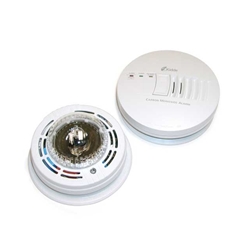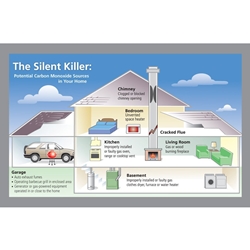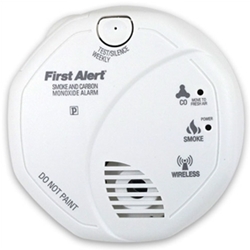Carbon monoxide (CO) is a colorless, odorless gas and the number one cause of poisoning deaths in the United States. Because it has no smell, taste or color, it is difficult to detect. In fact, you can inhale carbon monoxide without even realizing it! Many states, towns and counties require private homes and rental apartments to have at least one carbon monoxide detector, and that’s a good start. However, unless you live in a small one-level apartment, your home should really have more that one carbon monoxide detector to adequately protect your family. Here’s why.
What is Carbon Monoxide?
Carbon monoxide is a natural byproduct of combustion and is produced by vehicles, appliances and other equipment that burn gas and other petroleum products, as well as wood and other fuels.
The danger occurs when too much carbon monoxide accumulates in an enclosed or semi-enclosed poorly ventilated space. This is why it’s so important to open the garage door when your car is running and to properly vent fuel-burning appliances, furnaces, water heaters, clothes dryers, ovens and ranges. Breathing in air with a high concentration of CO can greatly diminish your body’s ability to absorb oxygen, leading to serious tissue damage that causes sudden illness and death.
Carbon Monoxide Detector Technology
Since you can’t see or smell carbon monoxide, carbon monoxide detectors are used to monitor a buildup of carbon monoxide gas in homes and sound an audible alarm warning if the level gets too high. There are three basic CO detector technologies, each with a different type of sensor – metal oxide, biomimetic and electrochemical. While there are differences between these technologies, each is tested and approved for operation.
Types of CO Detectors (Based on Power Source)
There are three basic designs of carbon monoxide detectors, based on the power source. Each type has advantages and disadvantages.
- Battery-powered: Easy to install and typically the least expensive. The biggest advantage is that these detectors continue to operate during power outages. However, you must remember to change the battery at least once a year.
Â
 Hard-wired: Preferred by many homeowners, the biggest advantage of hard-wired units is that they can be linked to each other. If one of them is triggered by a CO event, all of the alarms in your home will sound a warning. The Kidde Lifesaver is an example of an “interconnectable†alarm. Choose only hard-wired units that have a battery backup to ensure continuous protection during power outages.
Hard-wired: Preferred by many homeowners, the biggest advantage of hard-wired units is that they can be linked to each other. If one of them is triggered by a CO event, all of the alarms in your home will sound a warning. The Kidde Lifesaver is an example of an “interconnectable†alarm. Choose only hard-wired units that have a battery backup to ensure continuous protection during power outages.
- Plug-in: This type is easy to use because it plugs into an electric outlet. The disadvantage of plug-in models is placement, since most electrical outlets are located low on the wall, whereas optimal placement of CO detectors is higher up near the ceiling.
Â
Proper Placement – Why More Than One CO Detector is Best
No matter which type of CO detector you choose, placement and installation is essential for proper functioning. CO detectors can vary by manufacturer so be sure to follow their instructions. To ensure that your entire home is protected, follow these guidelines for how many carbon monoxide detectors you need and where to position them:
- Place detectors on every floor, including basements as well as attics that are used for more than storage. If you have only one CO detector located on the main living area, a dangerous buildup of CO on another level of your home (such as in the basement near the furnace) will go undetected even though the main level is safe.

- Place detectors in or near sleeping areas, where the sound of an alarm will easily wake people up. Within 15 feet of each bedroom door is recommended.
- Place a detector near (but not inside) an attached garage. You should also place a detector in any room situated directly above your garage.
- Place detectors near the ceiling or high on the wall. CO gases are the same weight as air and tend to combine with warmer air and rise.
- DO NOT place detectors within 15 feet of fossil fuel burning cooking or heating appliances. Likewise, avoid placement detectors near ceiling fans, vents, or air conditioners that may affect performance.
Special Types of CO Detectors
Combination Smoke & CO Detectors
Many manufacturers offer carbon monoxide detectors that also function as smoke detectors, so you can protect your family from both threats with one device. Look for combination detectors that activate independently and have distinctly different alarm signals for smoke or high CO levels, such as the Gentex Hard Wired Combo Smoke and CO Alarm.
If your home is equipped with a Z-Wave home automation controller or a Z-Wave alarm system, a Z-Wave carbon monoxide detector can be used to trigger a series of “events†(e.g., turn the lights on or shut down the HVAC system) if an excess amount of CO is detected. First Alert offers a combination smoke and carbon monoxide Z-Wave detector that works with any Z-Wave controller.
Â
Protection for the Hard of Hearing
If you or someone in your family is deaf or has hearing loss, protect them with a carbon monoxide detector that also has a visual alarm, like the Silent Call Carbon Monoxide Detector with Strobe Light or the hard-wired Kidde Lifesaver Carbon Monoxide Alarm with Strobe.
Â
Connect CO Detectors to Your Home Security System
For the ultimate protection, connect your carbon monoxide detectors to your home’s home security system or autodialer so you’ll be alerted if there is a high level of CO gas even when you are away from home. A carbon monoxide detector connected to a central monitoring station is a good way to protect your family at nighttime when everyone is asleep. If a high concentration of CO gas is detected, the monitoring station will call the proper authorities to investigate.
For more information on the risks of CO poisoning, read “Know the Signs of Carbon Monoxide Poisoning.â€





